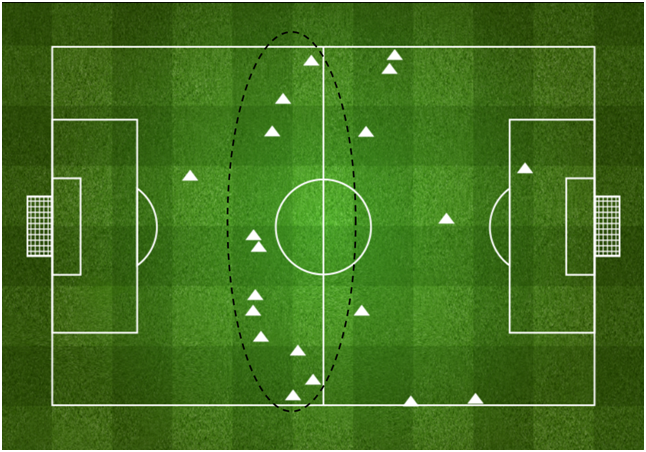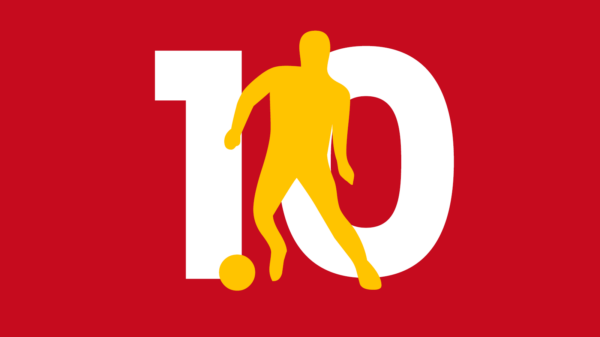Siyang Xu writes a detailed tactical analysis about the La Liga match that ended Atletico Madrid 0-3 Real Madrid.
Real Madrid extended their unbeaten run in La Liga to 24 matches with a comprehensive victory in the last ever derby to take place at the Vicente Calderon. Atletico had not lost at home in the league for over a year but Zidane successfully came up with a game plan to maintain his unbeaten away league record since taking over as Real Madrid manager.

Made using TacticalPad
Atletico Madrid: 13. Oblak; 20. Juanfran, 15. Savic, 2. Godin, 3. F. Luis; 8. Saul, 6. Koke, 14. Gabi, 10. Carrasco; 7. Griezmann, 9. Torres.
Real Madrid: 1. Navas; 2. Carvajal, 5. Varane, 6. Nacho, 12. Marcelo; 19. Modric, 6. Kovacic, 22. Isco; 17. Vazquez, 7. C. Ronaldo, 11. Bale.
Real Madrid’s press-resistance
Both sides lined up in a 4-4-2 (/4-4-1-1) and the two similar shapes lead to something of a stalemate for most of the match. As a result, it looked like the match would largely be decided in transitions and it was in these phases that Real were able to take control of the game. With Atletico spending much of their time in a deep block, they struggled to get out and launch effective counter attacks. This was largely down to the poor performance of Fernando Torres and the tight man-marking and aggressive defending of Real Madrid’s centre backs against Antoine Griezmann, enabling the visitors to regain possession quickly before Atletico could get out of defence to support.
Subsequently, Atletico’s next best threat in transition would be their counterpressing high up the pitch. By winning the ball immediately after losing it, they could look to attack Real at the moment they were most disorganised. However, the profile of Real Madrid’s midfield for this game (with Isco and Kovacic playing, rather than Casemiro and Kroos) meant that they had plenty of extremely technical, agile players who were capable of carrying and protecting the ball under pressure. These players were able to bypass the Atletico counterpress and essentially nullify Atletico’s threat on the counter. The clip below shows several examples of this. Note how the players use their body position and balance to protect the ball, enabling them to either dribble away or win a foul.
By winning fouls in these phases, they immediately stopped Atletico’s transition and forced them to drop back into their defensive shape, pushing them deeper down the field and consequently reducing their threat in attacking areas. By doing this repeatedly throughout the match (the diagram below highlights the number of fouls Real Madrid suffered in the area just inside their own half in midfield), they not only frustrated the Atletico players and crowd but also managed to steer the game away from transitions, where Atletico are most dangerous, and into an attack vs defence scenario whereby they could get into their attacking structure and have possession to build. This also helped Real as it meant they did not have to build from the back too often, where Atletico could press high and force them into mistakes, but instead start attacks from near the halfway line, negating the need for the first phase of build up.

Real Madrid also protected themselves from being pressed by showing caution in their build up from the back. Atletico pressed high and hoped to catch Real out by setting pressing traps in wide areas, but Real were careful not to overplay and were always happy to hit long balls even if it meant the loss of possession, knowing that Atletico were not particularly dangerous in their own attacking phase. This meant that Atletico rarely won the ball high up the pitch and that Real were never disorganised when facing an Atletico attack.
Real’s deep block
Although their dominance in transitions enabled them to control much of the possession, Real still struggled to create clear chances against Atletico’s organised defence. However, when they were able to score a goal via a fortunate deflection from a Ronaldo free kick, this no longer mattered and it became clear after half time that their strategy would be to sit back on their lead and try and score on the counter.
This led to quite a strange second half in that Real Madrid sat back in a deep defensive block, asking Atletico to try and break them down. This is particularly unusual for the usually attack-minded side and credit has to be given to Zinedine Zidane for getting his players to convincingly execute this particular game plan. The aura created by his playing career and the subsequent excellent man-management from Zidane is arguably his best quality, and is probably the main reason Real Madrid have been excellent in big games since his reign began. He even managed to get Ronaldo to participate in defensive pressing at times!
Atletico largely struggled to break down Real’s compact block, regularly resorting to crossing which isn’t a particularly effective strategy against a team who have settled into a defensive shape. When they did manage to play in between the lines, the subsequent support was not there for the player receiving the ball, meaning he could be quickly isolated and pressured into losing the ball. There was also a surprisingly lack of quality in many of these passes, often being overhit.
There were moments when Atletico used good movement to pull apart a man-orientated Real Madrid defence, but these were too few and far between. This was largely down to a poor central attacking structure, in which it was difficult for the midfield to link with the two strikers. An occasion where Atletico did well to create an opportunity is shown below.
Despite dominating the second half, Atletico ultimately failed to break through and Ronaldo was able to score a second with a penalty after 71 minutes, before adding a third later on. The way in which Atletico gave away the penalty will be particularly frustrating to them, as a simple header from Varane sent Ronaldo in behind the defence before Stefan Savic brought him down inside the box.
Conclusion
Contrary to what the one-sided scoreline suggested, the match was a fairly balanced one. Despite Real managing to nullify Atletico’s transitions, they themselves had little to offer when asked to break Atletico down. Similarly in the second half, the roles were reversed but with little difference in result.
Credit has to be given to Zidane for Real’s pragmatic performance, not letting them be either pressed in build up or counterpressed in transition. Whoever scored the first goal in such a tight, cagey game would always have the advantage, and fortunately for Real it was them who scored a deflected free kick. From then on, the visitors’ game management was spot on and saw the game out in an exemplary manner.
Read all our Tactical Analyses here.
- Liverpool 3-2 PSG: Liverpool edge deserved victory against dysfunctional PSG - September 21, 2018
- Tactical Analysis: France 1-0 Belgium | Set Piece Decides Game Dominated by Determined Defences - July 14, 2018
- Tactical Analysis: Manchester City 4-1 Tottenham Hotspur | Guardiola extends winning run to 16 - December 20, 2017


























































